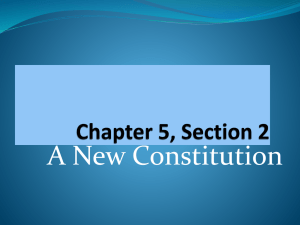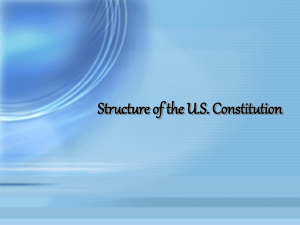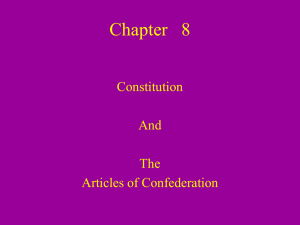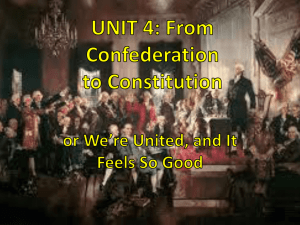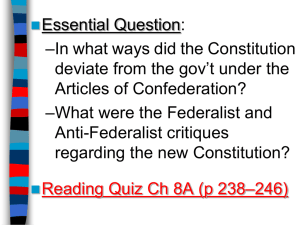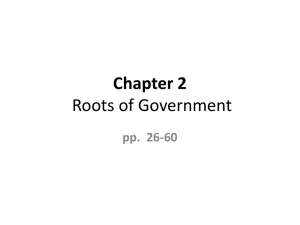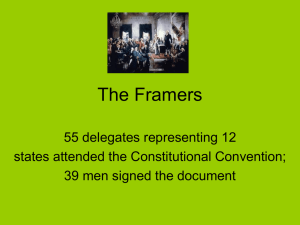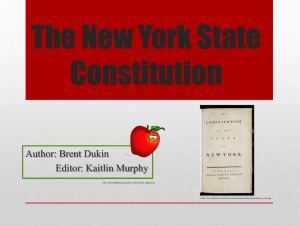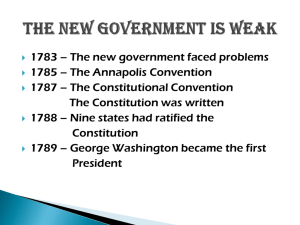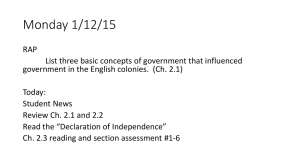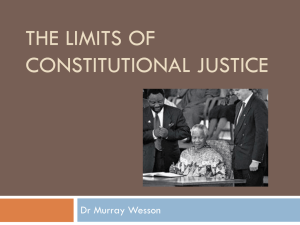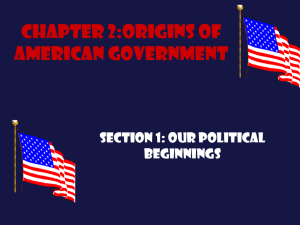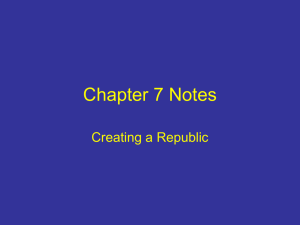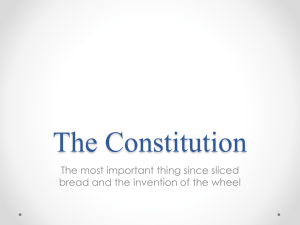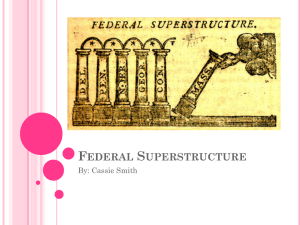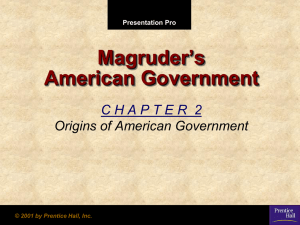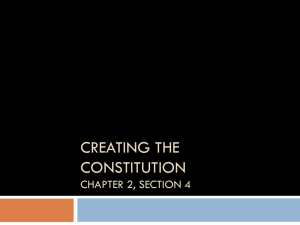CHAPTER 6 THE REPUBLICAN EXPERIMENT
advertisement
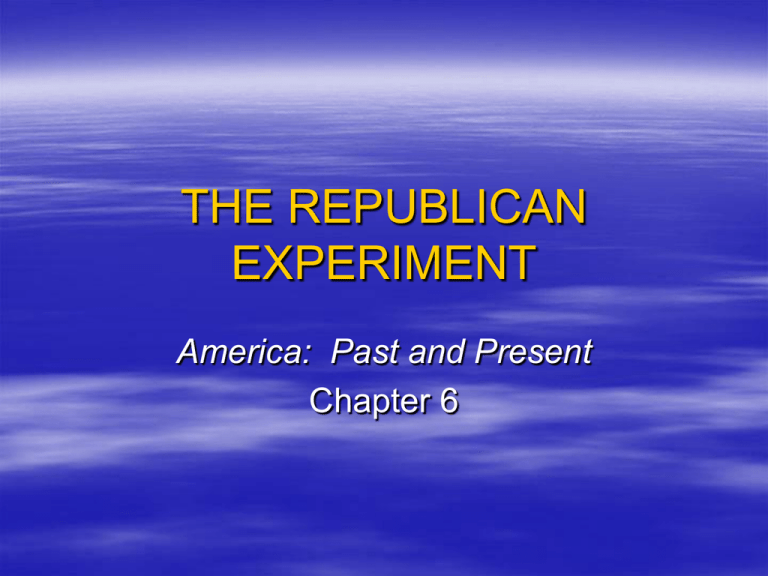
THE REPUBLICAN EXPERIMENT America: Past and Present Chapter 6 Defining Republican Culture Post-Revolutionary Divisions – – balancing individual liberty with social order balancing property rights with equality Varying answers result in varying Revolutionary governments Living in the Shadow of Revolution Revolution introduced unintended changes into American society Hierarchical social relations challenged Fundamental questions raised about the meaning of equality Social and Political Reform Changes in laws of inheritance More liberal voting qualifications Better representation for frontier settlers Separation of church and state African Americans in the New Republic African Americans embrace Declaration’s stress on natural rights Demand right to freedom in petitions, suits Northern states gradually abolish slavery Southerners debate abolition – – some privately free slaves economic motives overcome republican ideals The Challenge of Women's Rights Women demand the natural right of equality Contribute to new society through “Republican Motherhood” Women more assertive in divorce, economic life Denied political and legal rights Postponing Full Liberty Revolution limited in extension of rights Introduced ideal of freedom and equality Future generations would make these ideals reality The States: Experiments in Republicanism The people demand written constitutions – – provide clear definition of rights describe clear limits of government Revolutionary state constitutions serve as experiments in republican government Insights gleaned from state experiences later applied to constructing central government Blueprints for State Government State constitution writers insist on preparing written documents Precedents in colonial charters, church covenants Major break with England’s unwritten constitution Natural Rights and the State Constitutions State constitutions guarantee cardinal rights – – – – freedom of religion freedom of speech freedom of the press private property Governors weakened Elected assemblies given most power Power to the People Procedure for adoption of Constitution pioneered by Massachusetts – – Constitution written by a special convention ratification by referendum of the people State constitutions seen as flawed experiments Growing sentiment for stronger central government Stumbling Toward a New National Government War for independence requires coordination among states Central government first created to meet wartime need for coordination Articles of Confederation John Dickinson’s plan for central government – – proposed cession of West to Congress opposed proposed equality in state representation opposed Articles of Confederation severely limit central government’s authority over states States suspicious of Articles Western Land: Key to the First Constitution Maryland ratification of Articles delayed for Virginia’s renunciation of Western claims 1781--Virginia takes lead in ceding Western claims to Congress Other states cede claims to Congress Congress gains ownership of all land west of Appalachians Western Land Claims Ceded by the States Northwest Ordinance: The Confederation's Major Achievement Creates 3-5 new territories in Northwest Population of 5,000 may elect Assembly Population of 60,000 may petition for statehood Bill of Rights provided Slavery outlawed Northwest Territory Land Ordinance of 1785 Strengthening Federal Authority Inadequate authority over interstate affairs Inadequate influence on national economy Weak foreign policy The Nationalist Critique Congress unable to address inflation, debt Congress has no power to tax Failure to pay soldiers sparks “Newburgh Conspiracy” (squelched by Washington) Failure of reform prompts Nationalists to consider Articles hopelessly defective Diplomatic Humiliation England keep troops on U.S. soil after 1783 Spain closes New Orleans to American commerce in 1784 – John Jay to negotiate reopening Mississippi – instead signs treaty favoring Northeast – West and South denounce, Congress rejects Jay-Gardoqui Treaty “Have We Fought for This?” By 1785 the country seemed adrift Washington: “Was it with these expectations that we launched into a sea of trouble?” The Genius of James Madison Recognition by 1780s of shortcomings in small state republics Stronger central government gains support James Madison persuades Americans that large republics could be free and democratic Constitutional Reform May 1786--Annapolis Convention agrees to meet again, write a new constitution Summer 1786--Shay’s Rebellion sparks fears of national dissolution Crisis strengthens support for new central government The Philadelphia Convention Convenes May 1787 55 delegates from all states except Rhode Island Delegates possess wide practical experience Inventing a Federal Republic: The Virginia Plan Central government may veto all state acts Bicameral legislature of state representatives Larger states have more representatives Chief executive appointed by Congress Small states object to large-state dominance Inventing a Federal Republic: The New Jersey Plan Congress given greater taxing powers Each state would have one vote in a unicameral legislature Articles of Confederation otherwise untouched Compromise Saves the Convention Each state given two delegates in the Senate--a victory for the small states House of Representatives based on population--a victory for the large states Three-fifths of the slave population counted toward representation in the House Compromising with Slavery Issue of slavery threatens Convention’s unity – – Northerners tend to be opposed Southerners threaten to bolt if slavery weakened Slave trade permitted to continue to 1808 “Great as the evil is, a dismemberment of the Union would be worse.” --James Madison The Last Details July 26—Committee of Detail formed to prepare rough draft Revisions to Executive – Electoral College ensures president will not be indebted to Congress – executive given a veto over legislation – executive may appoint judges Decision that Bill of Rights unnecessary We, the People Convention seeks to bypass vested interests of state legislatures Power of ratification to special state conventions Constitution to go into effect on approval by nine state conventions Phrase “We the People” makes Constitution a government of the people, not the states Whose Constitution? Struggle for Ratification Supporters recognized the Constitution went beyond the Convention’s mandate Document referred to states with no recommendation Federalists Supported the Constitution Well-organized Supported by most of the news media Anti-Federalists Opposed to the Constitution Distrusted any government removed from direct control of the people Suspected the new Constitution favored the rich and powerful Progress of Ratification Succeed in winning ratification in 11 states by June 1788 North Carolina ratifies November 1789 Rhode Island ratifies May 1790 Americans close ranks behind the Constitution Ratification of the Constitution Adding the Bill of Rights The fruit of Anti-Federalist activism Nationalists promise to add a bill of rights First ten amendments added by December 1791 Success Depends on the People Some Americans complained that the new government had a great potential for despotism Others were more optimistic and say it as a great beginning for the new nation
